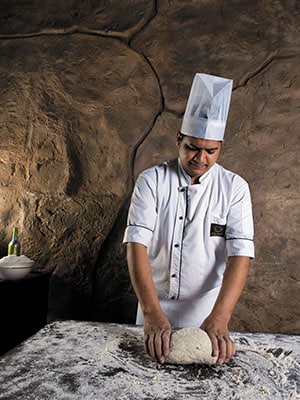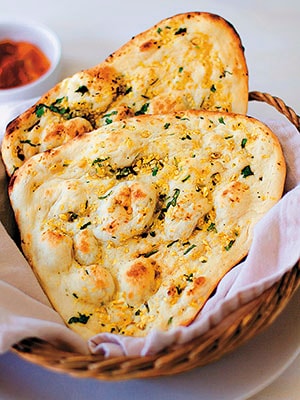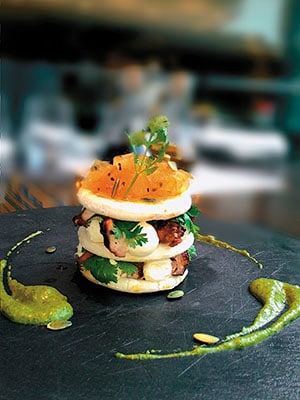
Breaking bread: Reinventing the naan
Subject to the capricious whims of the nation's palate, the naan was in danger of fading into the background. The last few years, though, have seen considerable reinvention and a grand revival
It is a rare north Indian meal that can fly solo without the comforting presence of a hot naan, fresh off the tandoor. But while we may have embraced the teardrop-shaped flatbread, it is not Indian in origin. No matter, because, much like some versions of biryani and even kebabs, the naan that we eat can arguably be considered India’s gift to the culinary world.
Archaeologists believe that the leavened bread could have been a part of the subcontinent’s diet during the Indus Valley Civilisation (3,300-1,300 BCE) because of the discovery of earthen pots and pans. But one of the earliest written references to the naan appears only centuries later, in 1300 AD, in the notes of Indo-Persian Sufi poet Amīr Khusrow.
When Emperor Babur—who was rumoured to have disliked Indian roti—brought the flatbread to the country from Persia (modern-day Iran) and Fergana Valley (Uzbekistan) in the early 16th century, it resembled unleavened pita, and was made from maida (finely milled wheat flour). This version of the flatbread was then baked, doused in lamb fat and served with kebabs.
While Babur was establishing the foundations of the Mughal Empire in India, the naan began to take shape: First, khamir (an addition of yogurt and yeast) was added to the dough, which was allowed to rest overnight in a practice called proving. And as tandoors (clay or metal ovens) became a fixture in Indian kitchens, the bread acquired the refined texture and taste we’ve come to love, with its crisp exterior, soft inside and an unmatched ability to hold curries well. This ‘absorbing’ quality contributed to its popularity, especially because it often served as an edible plate.

By then, the flatbread—a favourite among the Mughals—was being prepared in two ways: Naan-e-tunuk (an unleavened light bread) and naan-e-tanuri (cooked in a tandoor). The Ain-i-Akbari, or the Constitution of Akbar, a written record of the third Mughal emperor’s reign, talks about his love for naan, and how the otherwise frugal eater would roll kebabs or kheema (spiced minced meat) in it. According to Lucknow-based chef Mujbeer Rehman, the naan began to evolve as khansamas (royal master chefs) started to innovate with it. “They dressed the flatbread with toppings such as chilgoze (pine nuts), kalonji (onion seeds), dry fruits and even black sesame seeds,” says Rehman, a descendant of a long line of royal khansamas who served the predecessors of Raza Ali Khan Bahadur, the last nawab of Rampur. “It was during (Mughal Emperor) Shah Jahan’s reign that portable tandoors were introduced, and by 1700 the naan had reached the masses. It was a regular breakfast item in Lucknow, Bhopal and Rampur.”
It also appealed to European taste buds, reflected in the fact that it thrives in Britain’s culinary landscape. Restaurateur and food historian Jiggs Kalra tells ForbesLife India that during the Raj, two versions of the flatbread, kajur and khjuru, were popular breakfast staples. “While kajur was finger-sized thick bread, khjuru, which eventually became a popular snack, was sweet bread served with tea. In all likelihood, these were among the few variations of naans that the British and other foreigners were introduced to when they landed in India, and took a liking to,” says Kalra.
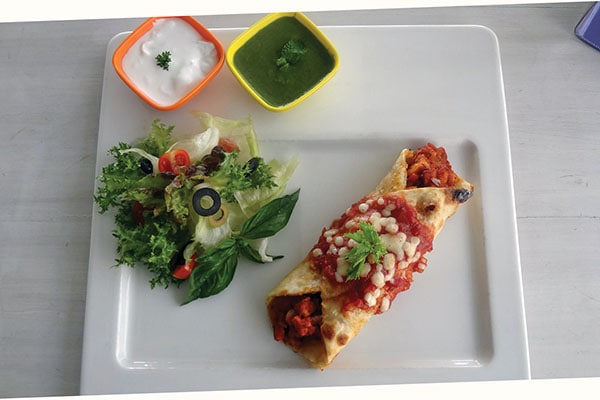
The Naanchilada served at the Park Calangute Goa is stuffed with black beans and chicken
The English likened the naan to their rye bread in taste and texture. “And by the time Veeraswamy, the UK’s oldest Indian restaurant opened in London in 1926, not only the British, but even the European palate was familiar with the flatbread,” says Sabyasachi Gorai, chef and founder of the Delhi-based hospitality consulting firm, Fabrica By Saby.
Veeraswamy would be among the several ‘Balti’ (a moniker for eateries that presented curries in a kadai) restaurants across the UK to serve naans with curries. “By the 1980s, companies like Honeytop Specialty Foods were packaging and commercialising naans in the UK. They had a 13-day shelf life, and gave rise to the naan bread,” adds Gorai.
But even as the naan was being embraced in England, it had already started losing ground in India. By the late ’40s, it was rarely being ordered in restaurants. “For Indian diners, rumali, not naan, became the celebratory bread, along with parathas, kulchas, missi rotis and tandoori rotis. Even smaller restaurants stopped making the flatbread, which was once the mainstay of every Indian’s meal,” says Vikas Seth, corporate chef, Dish Hospitality.
For a while, the naan faced the danger of fading into the background. But in 1977, it got a shot in the arm with the launch of ITC Maurya’s Bukhara in Delhi. A north frontier cuisine specialty restaurant, Bukhara introduced its signature dish, the ‘Family Naan’: With a diameter of 4 ft, it was larger than a baby’s blanket, and required a special cooking apparatus. “It took us nearly three months to get the texture, bite, crunch and even the size and look perfect,” says Sanjay Mitra, who was part of the launch team. He is currently executive chef at Four Points by Sheraton, Pune.
It wouldn’t be amiss to say that, in many ways, Bukhara spearheaded a naan revival in Delhi. Much like the khansamas of the past, chefs in Delhi (and later in other cities) began innovating with the flatbread, which once again was placed at the centre of the bread basket.
A popular iteration, spawned by this spate of innovation, is the garlic naan. As the name suggests, a pod of garlic is smeared on the surface of the flatbread as it cooks on the tandoor. To drive home the garlicky flavour, many restaurants add a splash of garlic oil and a generous sprinkle of garlic chips before bringing it to the table.
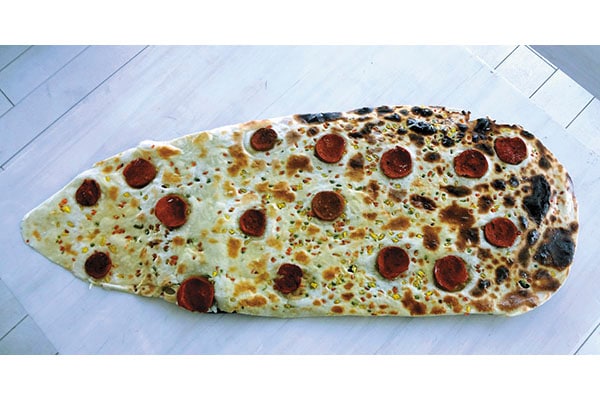
Food for thought: The Yard-Long Pepperoni Pizza
“Garlic made naan more likeable to vegetarian diners because it added a new element to the otherwise bland bread. Guests found that dal went better with garlic naan than it did with parathas. It gave that extra punch of flavour to a meal,” says Chetan Sethi, chef and owner of Zaffran, which specialises in Mughlai cuisine. Another mouth-watering innovation is the ‘Roghni’, a naan brushed with oil used to prepare Rogan josh (Mughlai lamb curry). “The Roghni raised the bar for the flatbread even higher,” Sethi adds.
In the Mumbai restaurant Masala Library by Jiggs Kalra, (one of the three eateries under the Massive Restaurants brand founded by Jiggs Kalra’s son Zorawar Kalra), one naan is a hero of the menu. It is neither a part of the bread basket nor a side dish to be used to mop up curry from a plate or dipped into a bowl of raita. Christened the ‘Guchchi Naan’, this earthy dish is stuffed with an expensive morel called sponge mushroom or guchchi that is grown in Kashmir and Himachal Pradesh.
That’s not all. Farzi Café in Gurgaon by Massive Restaurants has introduced a ‘Cornish Cruncher Naan’, topped with garlic and cheddar cheese after which it is baked in a clay oven and served alongside the restaurant’s take on the ubiquitous chicken tikka masala. Its third brand, Made in Punjab, serves ‘Kebabris’—bite-sized naans stuffed with cheese, chilli flakes, kalonji and garlic, and baked in the tandoor.
“The naan’s renewed popularity has brought to the fore other traditional breads that have evolved from it,” says Zorawar Kalra. These include the sheermal (saffron-flavoured leavened bread), taftaan (a leavened flatbread of Persian origin), khameer (breakfast bread usually served with cheese) and bakarkhani (thick, spiced flatbread with a biscuit-like texture). According to Kalra, these variations helped strengthen the naan’s position. He cites, by way of example, the delicate presentation of a melt-in-the-mouth galouti kebab on sheermal, which is often served as a canapé.
The naan’s place in Indian cuisine was cemented by 2000, when it became a bar food staple ithen pubs and restaurants. “Shaped as mini nachos, these bar nibbles were an assortment of naans that were flavoured differently and could be paired with different types of alcohol, including wine. It is still served as a complimentary snack in place of the conventional chaknas at Ziya, the Indian cuisine restaurant at The Oberoi in Mumbai,” says Kunal Kapur, TV show host and executive sous chef at The Leela, Gurgaon. Four Points by Sheraton serves an assortment of bite-sized naans like the Roghni, Peshawari (a sweet-savoury naan lashed with aromatic spices and stuffed with dry fruits) and Razela (spiced naan) on a platter.
The naan’s versatility and ability to blend smoothly with different flavours makes it an excellent substitute for other flatbreads, a fact The Park Calangute Goa exploited when it decided to replace the traditional pizza base with freshly made naan in its dish, ‘Yard-Long Pepperoni Pizza’. It was introduced two years ago. “The dish has all the toppings of a classic pepperoni pizza, only the base is a naan,” says Saurabh Khanna, general manager (operations).
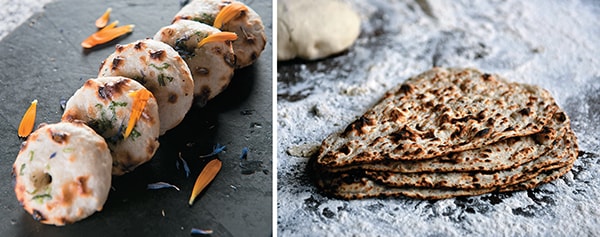
Yet another variation that the hotel offers is the ‘Naanchilada’, freshly baked mini-naan stuffed with a mix of chicken tikka, black beans, jalapeños and chipotle sauce. It is then shaped into something that resembles a Swiss roll, and is topped with some chunky tomato salsa and grated cheese before being baked and served hot. Palladium Hotel’s Japanese restaurant Yuuka in Mumbai makes a ‘Naan Bread Taquito’, a rolled taco naan filled with slow roasted carrots, beets, pickled chayote, and a salsa fresco called pico de gallo.
By 2013, the naan had not only regained its once celebratory status, it was part of the fabric of Indian fine dining. The Hyatt Regency Mumbai’s restaurant Glasshouse has a ‘made-on-order’ dish, ‘Chicken Mango Chutney Naan Bread Mille-Feuille’, small roundels of proven naan dough baked in the shape of a tower. The naan at the bottom is smeared with mango chutney and topped with roasted pumpkin seeds. The naan on top of it has a cream cheese layer with herb-spiced diced chicken.
Some brave restaurants are even celebrating the naan in their desserts: The Alila Diwa Goa, for one, serves up an ‘Almond and Gulkand Naan Roll’, inspired by Kashmiri cuisine’s flaky pastries. This variation has a layer of almond paste, is topped with a mix of gulkand- or rose-flavoured mawa (re-reduced milk) and roasted pistachio, and is then rolled and cut into pinwheels. Four Points By Sheraton serves the ‘Gazrella Naan’, a dish that draws inspiration from the naan thaal and the Maharashtrian delicacy, puran poli. It is made in two stages: First, a freshly baked naan is stuffed with gajjar ka halwa (sweetened grated carrot) and a dollop of ghee. It is then baked in the oven for a second time to get that extra crispiness. “This infuses smokiness to the halwa, which goes well with the naan,” says chef Sanjay Mitra, whose next experiment is turning the shahi tukda (fried bread soaked in sweetened milk and aromatic spices) into a naan tukda.
In her book, Cooking with Master Chefs, the late American chef Julia Child calls the naan, “a complete flatbread experience that gives food lovers a taste of faraway lands without ever boarding a plane”. She would have also been impressed by its resilience.
(This story appears in the May-June 2015 issue of ForbesLife India. To visit our Archives, click here.)
